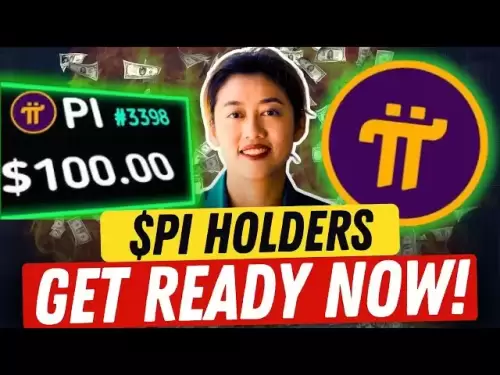-
 Bitcoin
Bitcoin $106,731.2224
-1.05% -
 Ethereum
Ethereum $2,444.9804
-1.20% -
 Tether USDt
Tether USDt $1.0003
0.01% -
 XRP
XRP $2.1882
0.09% -
 BNB
BNB $651.1435
-0.61% -
 Solana
Solana $148.3252
-2.09% -
 USDC
USDC $1.0000
0.01% -
 TRON
TRON $0.2787
0.55% -
 Dogecoin
Dogecoin $0.1598
-3.16% -
 Cardano
Cardano $0.5520
-2.43% -
 Hyperliquid
Hyperliquid $39.0960
-2.64% -
 Bitcoin Cash
Bitcoin Cash $516.9519
2.98% -
 Sui
Sui $2.7011
-2.95% -
 Chainlink
Chainlink $13.0582
-1.71% -
 UNUS SED LEO
UNUS SED LEO $8.9250
-2.53% -
 Stellar
Stellar $0.2359
-0.18% -
 Avalanche
Avalanche $17.3856
-3.73% -
 Toncoin
Toncoin $2.8095
-3.56% -
 Shiba Inu
Shiba Inu $0.0...01121
-1.95% -
 Litecoin
Litecoin $85.2795
-0.85% -
 Hedera
Hedera $0.1471
-2.15% -
 Monero
Monero $319.8004
1.12% -
 Dai
Dai $1.0001
0.01% -
 Ethena USDe
Ethena USDe $1.0001
0.02% -
 Bitget Token
Bitget Token $4.5344
-1.07% -
 Polkadot
Polkadot $3.3224
-2.96% -
 Uniswap
Uniswap $6.9697
-2.75% -
 Aave
Aave $266.1658
-2.25% -
 Pepe
Pepe $0.0...09414
-3.41% -
 Pi
Pi $0.4913
-3.29%
How to buy and sell Bitcoin on Binance? Step-by-step guide
Buying and selling Bitcoin on Binance is easy once you set up an account, deposit funds, and navigate the trading platform effectively.
Apr 06, 2025 at 08:28 pm
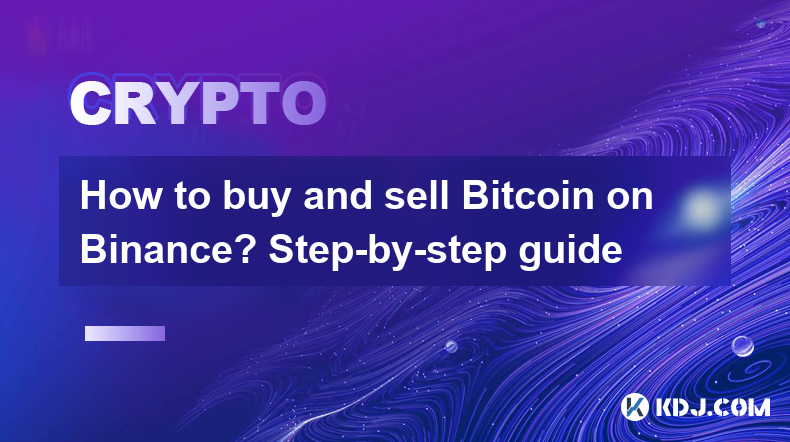
Buying and selling Bitcoin on Binance is a straightforward process, but it requires a clear understanding of the steps involved. Binance is one of the largest cryptocurrency exchanges globally, offering a wide range of trading options for Bitcoin and other cryptocurrencies. Whether you're a beginner or an experienced trader, understanding how to navigate the platform can enhance your trading experience. This guide will walk you through the process of buying and selling Bitcoin on Binance, from setting up your account to executing your first trade.
Setting Up Your Binance Account
Before you can start trading Bitcoin on Binance, you need to set up an account. Here's how you can do it:
- Visit the Binance website: Go to the official Binance website and click on the "Register" button.
- Enter your details: Fill in your email address and create a strong password. Make sure to use a password that is difficult to guess and includes a mix of letters, numbers, and symbols.
- Complete the verification process: Binance requires users to complete a Know Your Customer (KYC) verification process. You'll need to provide a government-issued ID and a selfie to verify your identity. This step is crucial for security and compliance reasons.
- Enable two-factor authentication (2FA): For added security, enable 2FA on your account. You can use an authenticator app like Google Authenticator or Authy to generate a unique code each time you log in.
Depositing Funds into Your Binance Account
Once your account is set up and verified, you'll need to deposit funds to start trading. Here's how to do it:
- Navigate to the "Wallet" section: Click on the "Wallet" tab at the top of the page, then select "Overview."
- Choose your deposit method: You can deposit funds using various methods, including bank transfer, credit/debit card, or cryptocurrency. For buying Bitcoin, you might want to deposit fiat currency or another cryptocurrency.
- Select the currency: If you're depositing fiat, choose your preferred currency (e.g., USD, EUR). If you're depositing cryptocurrency, select the one you want to use.
- Follow the instructions: Depending on your chosen method, follow the on-screen instructions to complete your deposit. For bank transfers, you'll need to provide your bank details. For cryptocurrency deposits, you'll receive a wallet address to send your funds to.
Buying Bitcoin on Binance
With funds in your account, you're ready to buy Bitcoin. Here's a step-by-step guide:
- Navigate to the trading section: Click on the "Trade" tab at the top of the page, then select "Basic" for a simpler interface or "Advanced" for more trading options.
- Select the Bitcoin trading pair: Choose the trading pair you want to use, such as BTC/USDT (Bitcoin against Tether) or BTC/USD (Bitcoin against US Dollar).
- Enter your order: Decide whether you want to place a market order or a limit order. A market order will buy Bitcoin at the current market price, while a limit order allows you to set a specific price at which you want to buy.
- Review and confirm: Double-check your order details, then click "Buy BTC" to execute the order. Your Bitcoin will be credited to your Binance wallet once the order is filled.
Selling Bitcoin on Binance
Selling Bitcoin on Binance is just as straightforward as buying. Here's how to do it:
- Navigate to the trading section: As with buying, go to the "Trade" tab and select either "Basic" or "Advanced."
- Select the Bitcoin trading pair: Choose the trading pair you want to use for selling, such as BTC/USDT or BTC/USD.
- Enter your order: Decide whether you want to place a market order or a limit order. A market order will sell your Bitcoin at the current market price, while a limit order allows you to set a specific price at which you want to sell.
- Review and confirm: Double-check your order details, then click "Sell BTC" to execute the order. Your funds will be credited to your Binance wallet once the order is filled.
Withdrawing Funds from Binance
After selling your Bitcoin, you might want to withdraw your funds. Here's how to do it:
- Navigate to the "Wallet" section: Click on the "Wallet" tab at the top of the page, then select "Overview."
- Choose your withdrawal method: You can withdraw funds using various methods, including bank transfer or cryptocurrency. For withdrawing fiat, you'll need to use a bank transfer. For cryptocurrency withdrawals, you'll need to provide a wallet address.
- Select the currency: Choose the currency you want to withdraw (e.g., USD, EUR, or a specific cryptocurrency).
- Follow the instructions: Depending on your chosen method, follow the on-screen instructions to complete your withdrawal. For bank transfers, you'll need to provide your bank details. For cryptocurrency withdrawals, you'll need to enter the recipient's wallet address.
Tips for Safe Trading on Binance
Trading on Binance can be safe and efficient if you follow some best practices. Here are some tips to keep in mind:
- Use strong passwords and enable 2FA: Always use a strong, unique password for your Binance account and enable two-factor authentication to add an extra layer of security.
- Be cautious of phishing attempts: Be wary of emails or messages that ask for your login details or personal information. Always access Binance through the official website.
- Keep your private keys secure: If you're using a hardware wallet to store your Bitcoin, make sure to keep your private keys safe and never share them with anyone.
- Monitor your account activity: Regularly check your account for any unauthorized transactions or suspicious activity. Report any issues to Binance support immediately.
- Stay informed about market trends: Keep up-to-date with the latest news and trends in the cryptocurrency market to make informed trading decisions.
Understanding Fees on Binance
Binance charges fees for trading and withdrawing funds. Understanding these fees can help you manage your trading costs effectively. Here's a breakdown of the fees you might encounter:
- Trading fees: Binance uses a maker-taker fee model. Makers (those who add liquidity to the market) pay a lower fee than takers (those who remove liquidity). The standard fee for makers is 0.1%, while the fee for takers is 0.1%. However, you can reduce these fees by holding Binance Coin (BNB) or by increasing your trading volume.
- Withdrawal fees: Binance charges a fee for withdrawing funds, which varies depending on the cryptocurrency you're withdrawing. For Bitcoin, the withdrawal fee is typically around 0.0005 BTC, but this can change based on network conditions.
- Deposit fees: Depositing fiat currency may incur a fee, depending on your chosen method. Cryptocurrency deposits are usually free, but you should check the specific fees for your chosen cryptocurrency.
Using Binance's Advanced Trading Features
Binance offers a range of advanced trading features that can enhance your trading experience. Here are some of the key features you might want to explore:
- Stop-Limit Orders: These orders allow you to set a stop price and a limit price. When the market reaches the stop price, a limit order is triggered, helping you manage risk and protect your profits.
- Trailing Stop Orders: These orders automatically adjust the stop price as the market moves in your favor, allowing you to lock in profits while minimizing losses.
- Margin Trading: Binance offers margin trading, which allows you to borrow funds to increase your trading position. This can amplify your potential profits but also increases your risk, so use it cautiously.
- Futures Trading: Binance also offers futures trading, where you can trade Bitcoin and other cryptocurrencies with leverage. This can be a powerful tool for experienced traders but comes with significant risk.
Common Questions About Buying and Selling Bitcoin on Binance
Q: How long does it take to buy Bitcoin on Binance?
A: The time it takes to buy Bitcoin on Binance depends on the type of order you place. A market order is usually executed instantly, while a limit order may take longer to fill, depending on market conditions.
Q: Can I buy Bitcoin with a credit card on Binance?
A: Yes, Binance allows you to buy Bitcoin using a credit or debit card. You can find this option in the "Buy Crypto" section of the platform.
Q: What is the minimum amount of Bitcoin I can buy on Binance?
A: The minimum amount of Bitcoin you can buy on Binance depends on the trading pair and the current market price. For example, if you're buying BTC/USDT, the minimum order size might be around 0.001 BTC.
Q: How do I sell Bitcoin for fiat currency on Binance?
A: To sell Bitcoin for fiat currency, navigate to the trading section, select a trading pair like BTC/USD, and place a sell order. Once the order is filled, you can withdraw the fiat currency to your bank account.
Q: Are there any limits on buying and selling Bitcoin on Binance?
A: Yes, Binance has limits on buying and selling Bitcoin, which depend on your account verification level. Higher verification levels allow for higher trading limits.
Q: How can I track my Bitcoin transactions on Binance?
A: You can track your Bitcoin transactions in the "Wallet" section of Binance. Click on "Transaction History" to view all your past transactions, including deposits, withdrawals, and trades.
Q: What should I do if I encounter issues while buying or selling Bitcoin on Binance?
A: If you encounter any issues, you can contact Binance support through the "Support" section of the website. They offer various channels, including live chat, email, and a help center with FAQs.
Q: Can I use Binance on my mobile device?
A: Yes, Binance has a mobile app available for both iOS and Android devices. You can download it from the App Store or Google Play Store to trade Bitcoin on the go.
Q: Is it safe to leave my Bitcoin on Binance?
A: While Binance has robust security measures in place, it's generally recommended to transfer your Bitcoin to a secure wallet, such as a hardware wallet, for long-term storage. This adds an extra layer of security and gives you full control over your funds.
Q: How can I reduce trading fees on Binance?
A: You can reduce trading fees on Binance by holding Binance Coin (BNB) in your account. Binance offers a discount on trading fees for users who pay with BNB. Additionally, increasing your trading volume can also lower your fees.
Disclaimer:info@kdj.com
The information provided is not trading advice. kdj.com does not assume any responsibility for any investments made based on the information provided in this article. Cryptocurrencies are highly volatile and it is highly recommended that you invest with caution after thorough research!
If you believe that the content used on this website infringes your copyright, please contact us immediately (info@kdj.com) and we will delete it promptly.
- Pepeto: The Frog-Themed Meme Coin Set to Outperform in Q3 2025?
- 2025-07-02 05:10:12
- Altcoins, Collaboration, and Trump: A Wild Ride in Crypto
- 2025-07-02 05:10:12
- Tether, Bitcoin, and the Public Listing Frenzy: A New Era for Corporate Crypto?
- 2025-07-02 04:30:12
- SEC, Crypto ETFs, and the Fast Track: A New Era?
- 2025-07-02 05:50:12
- Bitcoin Cash Bullish Breakout: Price Hints at a $1,700 Rally?
- 2025-07-02 05:50:12
- Token Yugijo, Coin Flips & Meme Coins: What's Hot?
- 2025-07-02 04:30:12
Related knowledge
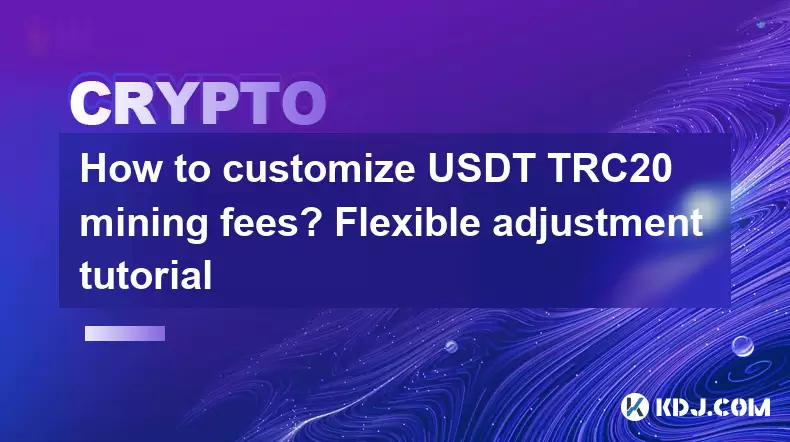
How to customize USDT TRC20 mining fees? Flexible adjustment tutorial
Jun 13,2025 at 01:42am
Understanding USDT TRC20 Mining FeesMining fees on the TRON (TRC20) network are essential for processing transactions. Unlike Bitcoin or Ethereum, where miners directly validate transactions, TRON uses a delegated proof-of-stake (DPoS) mechanism. However, users still need to pay bandwidth and energy fees, which are collectively referred to as 'mining fe...
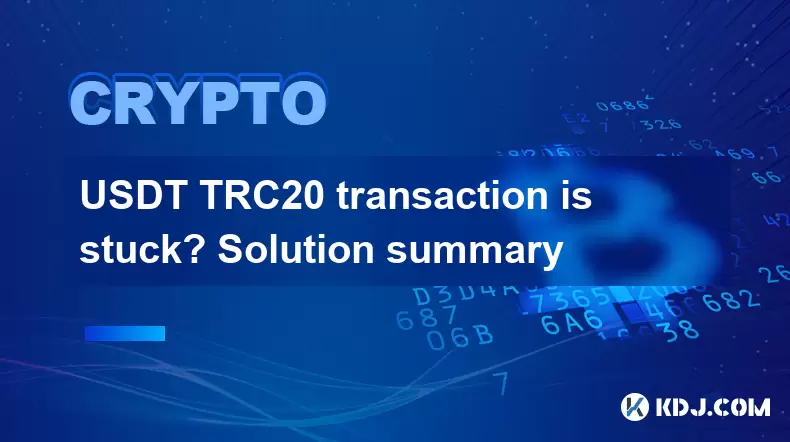
USDT TRC20 transaction is stuck? Solution summary
Jun 14,2025 at 11:15pm
Understanding USDT TRC20 TransactionsWhen users mention that a USDT TRC20 transaction is stuck, they typically refer to a situation where the transfer of Tether (USDT) on the TRON blockchain has not been confirmed for an extended period. This issue may arise due to various reasons such as network congestion, insufficient transaction fees, or wallet-rela...
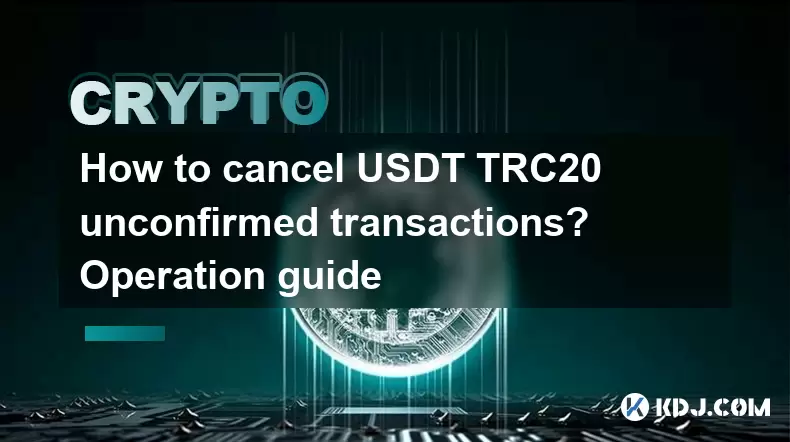
How to cancel USDT TRC20 unconfirmed transactions? Operation guide
Jun 13,2025 at 11:01pm
Understanding USDT TRC20 Unconfirmed TransactionsWhen dealing with USDT TRC20 transactions, it’s crucial to understand what an unconfirmed transaction means. An unconfirmed transaction is one that has been broadcasted to the blockchain network but hasn’t yet been included in a block. This typically occurs due to low transaction fees or network congestio...
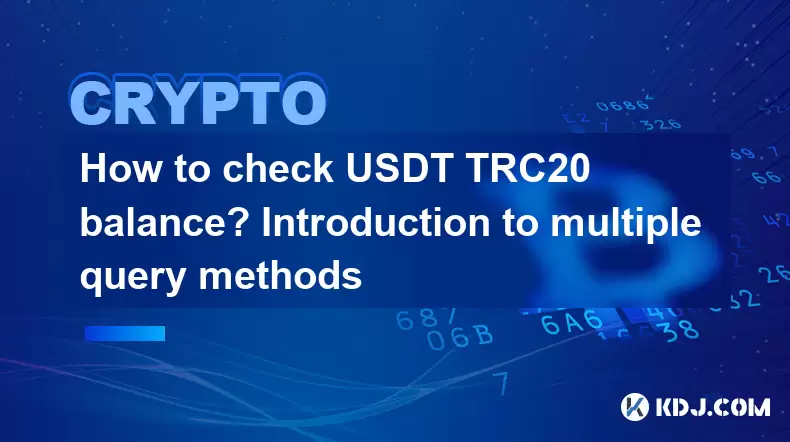
How to check USDT TRC20 balance? Introduction to multiple query methods
Jun 21,2025 at 02:42am
Understanding USDT TRC20 and Its ImportanceUSDT (Tether) is one of the most widely used stablecoins in the cryptocurrency market. It exists on multiple blockchain networks, including TRC20, which operates on the Tron (TRX) network. Checking your USDT TRC20 balance accurately is crucial for users who hold or transact with this asset. Whether you're sendi...
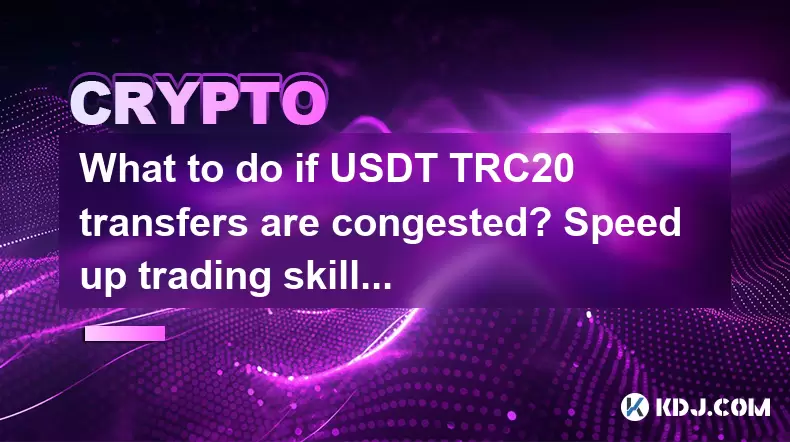
What to do if USDT TRC20 transfers are congested? Speed up trading skills
Jun 13,2025 at 09:56am
Understanding USDT TRC20 Transfer CongestionWhen transferring USDT TRC20, users may occasionally experience delays or congestion. This typically occurs due to network overload on the TRON blockchain, which hosts the TRC20 version of Tether. Unlike the ERC20 variant (which runs on Ethereum), TRC20 transactions are generally faster and cheaper, but during...
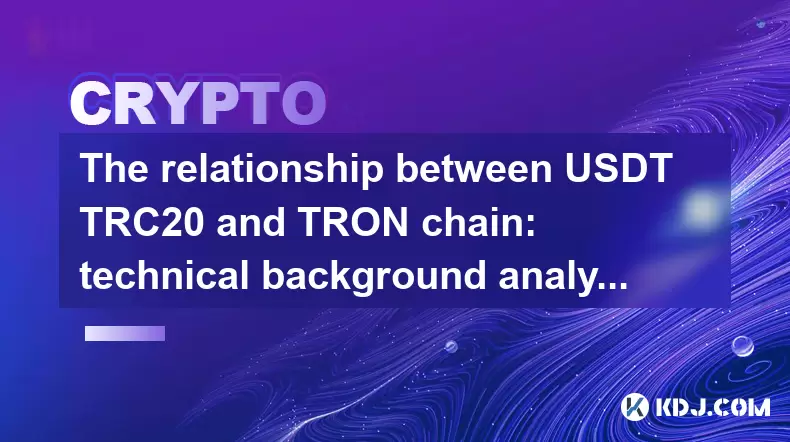
The relationship between USDT TRC20 and TRON chain: technical background analysis
Jun 12,2025 at 01:28pm
What is USDT TRC20?USDT TRC20 refers to the Tether (USDT) token issued on the TRON blockchain using the TRC-20 standard. Unlike the more commonly known ERC-20 version of USDT (which runs on Ethereum), the TRC-20 variant leverages the TRON network's infrastructure for faster and cheaper transactions. The emergence of this version came as part of Tether’s...

How to customize USDT TRC20 mining fees? Flexible adjustment tutorial
Jun 13,2025 at 01:42am
Understanding USDT TRC20 Mining FeesMining fees on the TRON (TRC20) network are essential for processing transactions. Unlike Bitcoin or Ethereum, where miners directly validate transactions, TRON uses a delegated proof-of-stake (DPoS) mechanism. However, users still need to pay bandwidth and energy fees, which are collectively referred to as 'mining fe...

USDT TRC20 transaction is stuck? Solution summary
Jun 14,2025 at 11:15pm
Understanding USDT TRC20 TransactionsWhen users mention that a USDT TRC20 transaction is stuck, they typically refer to a situation where the transfer of Tether (USDT) on the TRON blockchain has not been confirmed for an extended period. This issue may arise due to various reasons such as network congestion, insufficient transaction fees, or wallet-rela...

How to cancel USDT TRC20 unconfirmed transactions? Operation guide
Jun 13,2025 at 11:01pm
Understanding USDT TRC20 Unconfirmed TransactionsWhen dealing with USDT TRC20 transactions, it’s crucial to understand what an unconfirmed transaction means. An unconfirmed transaction is one that has been broadcasted to the blockchain network but hasn’t yet been included in a block. This typically occurs due to low transaction fees or network congestio...

How to check USDT TRC20 balance? Introduction to multiple query methods
Jun 21,2025 at 02:42am
Understanding USDT TRC20 and Its ImportanceUSDT (Tether) is one of the most widely used stablecoins in the cryptocurrency market. It exists on multiple blockchain networks, including TRC20, which operates on the Tron (TRX) network. Checking your USDT TRC20 balance accurately is crucial for users who hold or transact with this asset. Whether you're sendi...

What to do if USDT TRC20 transfers are congested? Speed up trading skills
Jun 13,2025 at 09:56am
Understanding USDT TRC20 Transfer CongestionWhen transferring USDT TRC20, users may occasionally experience delays or congestion. This typically occurs due to network overload on the TRON blockchain, which hosts the TRC20 version of Tether. Unlike the ERC20 variant (which runs on Ethereum), TRC20 transactions are generally faster and cheaper, but during...

The relationship between USDT TRC20 and TRON chain: technical background analysis
Jun 12,2025 at 01:28pm
What is USDT TRC20?USDT TRC20 refers to the Tether (USDT) token issued on the TRON blockchain using the TRC-20 standard. Unlike the more commonly known ERC-20 version of USDT (which runs on Ethereum), the TRC-20 variant leverages the TRON network's infrastructure for faster and cheaper transactions. The emergence of this version came as part of Tether’s...
See all articles
























